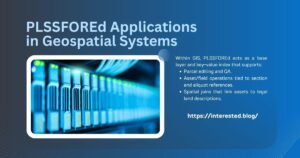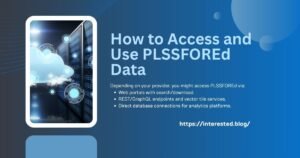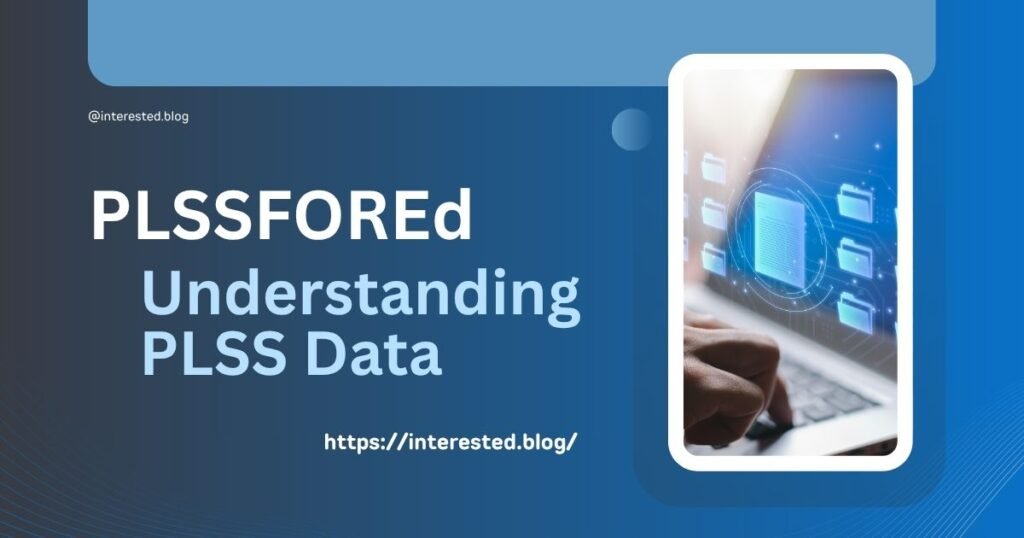Introduction
PLSSFOREd is best understood as a modern, data-forward way of working with the Public Land Survey System (PLSS). Think of it as a specialized framework, toolkit, and enriched dataset rolled into one—built to standardize, clean, align, and operationalize PLSS data for today’s mapping, surveying, and decision-support workflows. While the PLSS provides the foundational grid (townships, ranges, sections), PLSSFOREd provides the connective tissue: schema alignment, topology checks, coordinate normalization, metadata enrichment, and programmatic access that makes PLSS data truly usable at scale.
In short: PLSS is the “what” (a land grid), and PLSSFOREd is the “how” (the technology stack that makes the grid actionable).
Why PLSSFOREd Matters in Modern Geospatial Applications
From parcel mapping to wildfire mitigation planning, teams need clean, consistent, and queryable land grid data. PLSSFOREd matters because it:
- Normalizes legacy PLSS sources into a shared, machine-readable format.
- Improves positional integrity with spatial adjustments, snap rules, and topology checks.
- Automates workflows for updates, conflation, and QA/QC at enterprise scale.
- Packages APIs and export utilities that slot easily into GIS stacks, field apps, and data lakes.
Overview of the Role of PLSSFOREd in the PLSS (Public Land Survey System)
The PLSS grid is centuries old; its records are spread across agencies, formats, and vintages. PLSSFOREd serves as an integration and governance layer that:
- Harmonizes coordinate systems and datum references.
- Resolves edge conflicts between adjacent datasets.
- Adds metadata (lineage, accuracy, versioning).
- Publishes consistent outputs for analysis, apps, and reports.
The History and Evolution of PLSSFOREd
In the early days of digital mapping, PLSS datasets were often scanned maps, digitized lines, and spreadsheets with mixed quality. Utilities, counties, and timber companies each managed their own flavors. The seeds of PLSSFOREd began when practitioners started building repeatable scripts and schema to tame this messy data.
Key Developments Leading to the Creation of PLSSFOREd
Three shifts propelled the need for something like PLSSFOREd:
- Cloud & APIs: Organizations moved from desktop-only workflows to shared services and microservices.
- Precision Demands: High-resolution imagery, LiDAR, and GPS demanded tighter PLSS alignment.
- Compliance & Audits: Regulatory reporting required strict lineage, reproducibility, and version control.
Milestones in the Growth of PLSSFOREd Technology
- Transition from manual digitizing to automated topology validation.
- Introduction of schema templates and field dictionaries for PLSS attributes.
- Emergence of ETL pipelines (Extract-Transform-Load) tailored to PLSS ingestion.
- Availability of developer-friendly endpoints for query, tile rendering, and download.
Understanding PLSS Data and Its Importance
The PLSS subdivides land into a structured hierarchy—principal meridians, baselines, townships, ranges, sections, and smaller aliquots (e.g., NE ¼ of SW ¼). It creates a standardized reference system for land description, conveyance, and management across much of the United States.
PLSS Data: The Foundation of PLSSFOREd
PLSS data includes:
- Vector boundaries (townships, sections, aliquots, lots).
- Corner points and control monuments.
- Attribute tables (meridian, township, range, section, aliquot codes).
- Lineage, notes, adjustments, and survey dates.
PLSSFOREd consumes, reconciles, and enriches these layers.
The Role of PLSS Data in Mapping and Land Management
Whether you’re building a parcel map, siting a pipeline, or modeling habitat, PLSS data is the reference grid that ties locations to legal land descriptions—essential for ownership, permitting, assessment, and compliance.
How PLSSFOREd Works: A Deep Dive into the Technology
- ETL Pipelines: Ingest multiple PLSS sources; apply schema mapping and field validation.
- QA/QC Rules: Snap tolerances, sliver detection, topology repair, and geometry validation.
- Geodetic Controls: Datum alignment, projection normalization, and coordinate precision.
- Data Services: REST/GraphQL APIs for query; vector tiles for web maps; bulk export.
- Metadata & Lineage: Versioning, provenance, accuracy codes, and change logs.
How PLSSFOREd Enhances Accuracy in Surveying
PLSSFOREd does not replace authoritative surveys, but it tightens the base grid to reduce ambiguity:
- Applies corner prioritization (monumented > calculated > inferred).
- Incorporates local survey ties when available.
- Flags conflicts and suggests edge-matching resolutions.
- Supports iterative updates so improvements cascade to downstream users.
Key Features and Functions of PLSSFOREd
- Aliquot parsing & indexing for precise legal descriptions.
- Conflation between PLSS, parcels, and control networks.
- Multi-scale tiling for fast web maps.
- Compliance reporting (export lineages and accuracy).
- SDKs & scripts for automated integration.
Benefits of PLSSFOREd in Modern Mapping Technologies
Expect fewer mismatches between parcels, rights-of-way, and environmental layers—because the underlying grid is cleaner and better aligned.
Facilitating Easier Land Ownership Tracking
Legal descriptions snap to standardized grid units. That means title research, deed parsing, and chain-of-title mapping move faster and with fewer errors.
Cost-Efficiency and Time-Saving in Surveying
- Less time cleaning data; more time analyzing.
- Reduced rework during audits.
- Faster onboarding for new staff (consistent schema and documentation).
PLSSFOREd Applications in Geospatial Systems

Within GIS, PLSSFOREd acts as a base layer and key-value index that supports:
- Parcel editing and QA.
- Asset/field operations tied to section and aliquot references.
- Spatial joins that link assets to legal land descriptions.
Applications of PLSSFOREd in Land Management
Agencies and land trusts use it to track leases, easements, mineral rights, grazing allotments, and timber harvest units, ensuring that all spatial assets align with legal descriptions.
PLSSFOREd for Environmental Planning and Conservation
- Identify habitat units within specific sections.
- Prioritize conservation easements and mitigation banking.
- Align restoration projects with ownership and jurisdictional boundaries.
How PLSSFOREd Impacts the Real Estate Industry
Real estate pros rely on clear legal descriptions. PLSSFOREd helps:
- Cross-check deeds against the standardized grid.
- Visualize metes-and-bounds ties within PLSS sections.
- Spot discrepancies early (before closing).
Legal Implications of PLSSFOREd Data in Property Disputes
While a survey controls in court, PLSSFOREd strengthens discovery:
- Surfaces where historical descriptions conflict.
- Documents data lineage for expert testimony.
- Helps attorneys and appraisers frame the dispute quickly.
Integration of PLSSFOREd in Real Estate Development
Developers can combine PLSSFOREd with zoning, utilities, and environmental constraints to screen sites, phase subdivisions, and coordinate permitting.
The Relationship Between PLSSFOREd and Land Surveying
- Pre-field planning: identify control points and likely problem areas.
- In-field navigation: relate GPS observations to aliquot boundaries.
- Post-field reconciliation: integrate measured points back into the base grid.
The Accuracy of PLSSFOREd Compared to Traditional Methods
PLSSFOREd is not a substitute for a boundary survey, but it reduces uncertainty in desk-based planning and accelerates post-processing by providing a high-quality starting framework.
Tools and Software That Support PLSSFOREd in Surveying
Most mainstream GIS and survey CAD tools can consume PLSSFOREd exports (file geodatabases, GeoPackage, shapefiles, web services), and integrate them into CAD/GNSS workflows.
PLSSFOREd in Land Use Planning and Zoning
Planners can anchor growth models and future land use maps to sections and aliquots, providing a consistent spatial reference across departments.
Zoning and Land Development Regulations Enhanced by PLSSFOREd
- Reliable references for overlay districts.
- Easier tracking of variances and conditional use permits.
- Better public transparency with interactive section-based maps.
Streamlining Permitting and Licensing with PLSSFOREd
Automated checks can verify whether an application falls in the correct aliquot/lot, accelerating reviews and reducing back-and-forth.
PLSSFOREd and Government Land Management
Agencies manage leases, concessions, and rights across vast landscapes. PLSSFOREd standardizes the base grid, improving inter-agency coordination and auditability.
Integrating PLSSFOREd with Public Land Records
By linking land records, deeds, and PLSS aliquots, governments can publish authoritative maps with traceable provenance and update cycles.
How PLSSFOREd Simplifies Land Transfers and Sales
- Clean legal descriptions reduce title complications.
- Standard exports plug into auction, exchange, and appraisal platforms.
The Future of PLSSFOREd: Trends to Watch
- Event-driven pipelines that rebuild tiles and services when upstream data changes.
- Vector tiles with embedded metadata for instant context in web apps.
- Data contracts that enforce quality at ingestion.
How PLSSFOREd Will Evolve in the Next Decade
Expect deeper integration with 3D/4D geospatial, time-enabled land records, and IoT signals (e.g., construction sensors) that inform compliance and monitoring.
The Impact of AI and Machine Learning on PLSSFOREd
AI can help parse legal descriptions, detect boundary anomalies, and suggest conflations, while ML-based QC can flag suspicious edits before publication.
PLSSFOREd vs Other Mapping Technologies: A Comparison
- GPS: captures precise points/paths.
- PLSSFOREd: provides the legal/reference grid to contextualize those points within sections/aliquots.
PLSSFOREd vs Traditional Surveying Techniques
Traditional surveys measure on the ground for legal control; PLSSFOREd streamlines the data governance that surrounds those measurements.
Key Differences Between PLSSFOREd and Other GIS Data Sources
Unlike general basemaps or imagery, PLSSFOREd is domain-specific to land descriptions and cadastral governance, with built-in lineage and legal context.
Challenges and Limitations of PLSSFOREd
- Legacy scans and digitized lines can be imperfect.
- Edge discrepancies across jurisdictions may persist.
- Sparse control in remote areas hinders precision.
Legal and Privacy Concerns with PLSSFOREd Data
-
- Publishing ownership or PII needs careful governance.
- Use access controls, masking, and aggregation when appropriate.
Overcoming Technological Barriers to PLSSFOREd Adoption
- Provide training and documentation.
- Offer no-code/low-code tools for non-GIS staff.
- Align on data contracts and service-level agreements.
PLSSFOREd in Environmental Research and Sustainability
Researchers can align remote sensing analyses with PLSS units to track vegetation change, erosion, or fire perimeters in a legally meaningful frame.
Using PLSSFOREd for Conservation Projects
Conservation easements can be managed by aliquot, simplifying reporting and stewardship obligations.
Collaborating on Sustainable Land Management with PLSSFOREd
Public-private partnerships benefit from a shared reference grid, reducing ambiguity in multi-stakeholder projects.
How to Access and Use PLSSFOREd Data

Depending on your provider, you might access PLSSFOREd via:
- Web portals with search/download.
- REST/GraphQL endpoints and vector tile services.
- Direct database connections for analytics platforms.
Tools and Resources for Beginners to Learn PLSSFOREd
Start with:
- Schema guides and field dictionaries.
- Sample notebooks (Python/SQL) that show common queries.
Key Databases and Government Websites for PLSSFOREd
Look for official PLSS datasets (federal and state), then use PLSSFOREd to harmonize them into your environment.
The Role of PLSSFOREd in Disaster Management
Align hazard models (floods, fires, landslides) with PLSS sections to communicate risk in legal land terms familiar to planners and residents.
Improving Emergency Response with PLSSFOREd Data
Incident teams can reference section/aliquot IDs for dispatch, staging, and asset checks—especially where addresses are sparse.
Case Studies: PLSSFOREd’s Role in Disaster Recovery
After an event, PLSSFOREd helps teams document damage, coordinate claims, and track rebuild permits by consistent location keys.
How PLSSFOREd Data Enhances Land Policy Decision-Making
Policymakers can compare outcomes by section (e.g., tax revenue, conservation impact), leading to targeted adjustments.
How PLSSFOREd Data Shapes Land and Resource Legislation
Better data lineage and coverage means legislators can quantify effects of land bills and design more enforceable provisions.
Decision-Making Models Based on PLSSFOREd Data
- Scenario planning: simulate zoning shifts by aliquot.
- Equity analysis: assess how policies affect different areas across the grid.
- Cost-benefit: evaluate public works by section-level metrics.
Key Players in the PLSSFOREd Industry
Vendors deliver PLSSFOREd as managed services, SDKs, or on-prem toolkits that integrate into GIS/CAD stacks and cloud data warehouses.
Government Agencies Involved with PLSSFOREd Data
Agencies provide authoritative survey records and PLSS layers; PLSSFOREd stitches these into operational datasets for the public sector.
Notable Collaborations and Partnerships Driving PLSSFOREd Forward
Expect MOUs between agencies, utilities, universities, and conservation groups—aligning on data standards, QA rules, and update cadences.
Future Implications of PLSSFOREd for Global Geospatial Solutions
While PLSS is US-centric, the PLSSFOREd pattern—cleaning, standardizing, enriching a cadastral grid—can apply to other countries’ land systems.
How PLSSFOREd Can Impact International Land Agreements
Harmonized cadastral references can reduce friction in cross-border projects, transnational conservation, and infrastructure corridors.
Bridging the Gap: PLSSFOREd’s Role in Global Mapping Efforts
Open standards, shared schemas, and reproducible pipelines help translate local land grids into interoperable global datasets.
PLSSFOREd’s Role in Academic Research and Education
Students learn not just mapping, but data governance—lineage, QA, and reproducible ETL—using PLSSFOREd.
Integrating PLSSFOREd into Land Surveying and GIS Programs
Curricula blend legal land description with automation, preparing graduates for modern cadastral operations.
Collaborative Research Initiatives Featuring PLSSFOREd
Universities partner with agencies to test AI-assisted aliquot parsing, change detection, and law-tech integrations.
How PLSSFOREd Is Transforming the Way We Think About Land Ownership
Ownership becomes data-driven—traceable, auditable, and interoperable—so agencies and owners share a common, current picture.
Legal and Economic Impacts of PLSSFOREd on Land Rights
Clearer descriptions reduce transaction risk, speed underwriting, and support fairer assessments and transparent taxation.
The Future of Land Ownership and Distribution with PLSSFOREd
Expect richer digital twins of land where rights, restrictions, and responsibilities are machine-readable and consistently mapped.
Final Thoughts
PLSSFOREd brings order to cadastral complexity. By standardizing PLSS data and wrapping it with automation, lineage, and interoperable services, it upgrades land-based decisions from “hand-wavy” to defensible and scalable. For readers thinking about implementation: start small—define your schema, build a repeatable pipeline, and ship a high-quality base grid. Add services, APIs, and analytics one step at a time.
Balance perplexity (depth) with burstiness (readability) by layering the story: begin with why PLSSFOREd matters, show how it works, then demonstrate outcomes across surveying, real estate, planning, and policy. Do that well, and you’ll not only map the land—you’ll map trust into every decision that touches it.
Implementation Blueprint: Getting Started with PLSSFOREd (Step-by-Step)
- Inventory your sources
- Gather PLSS layers (sections, aliquots, corners).
- Collect parcel, control networks, and survey notes.
- Define a data contract
- Choose field names, domains, and required metadata.
- Set QA thresholds (e.g., allowable gaps/slivers).
- Build the ingestion pipeline
- Map fields to the PLSSFOREd schema.
- Normalize projections and datums.
- Run topology repair and corner prioritization.
- Publish services
- Serve vector tiles for web apps.
- Provide REST/GraphQL for queries.
- Offer bulk exports (FGDB, GPKG).
- Operationalize governance
- Version datasets; log changes.
- Set update cadences and ownership.
- Automate QA dashboards.
Best Practices & Pro Tips
- Prefer authoritative corners. Where monuments exist, use them; document substitutions.
- Track lineage relentlessly. Who changed what, when, and why.
- Keep humans in the loop. AI flags issues; experts adjudicate.
- Document exceptions. Edge cases become tomorrow’s standards.
- Design for interoperability. APIs, open schemas, and clear licenses.
Common Use Cases (With Quick Wins)
- Parcel QA: Snap parcels to PLSS lines; flag overlaps.
- Energy siting: Relate wells and pads to aliquots for lease compliance.
- Timber planning: Tie harvest units to sections for contract management.
- Emergency ops: Reference incidents by section/aliquot in rural areas.
- Conservation: Track easements and mitigation sites consistently.
Risk Mitigation Checklist
- Corner confidence: Rank corner sources; store accuracy codes.
- Datum alignment: Standardize CRS; store EPSG codes.
- Automated tests: Validate topology and attribute domains on every build.
- Legal review: Confirm how data can/can’t be used in proceedings.
- Access control: Limit sensitive attributes; log access.
Glossary (Plain-English Quick Reference)
- PLSS: US land grid of townships, ranges, sections, aliquots.
- Aliquot: Fractional subdivision of a PLSS section (e.g., NE ¼).
- Corner/Monument: Physical or recorded point marking boundaries.
- Conflation: Merging/editing to reconcile overlapping datasets.
- Topology: Rules about how boundaries connect (no gaps/overlaps).
- Lineage: History of changes to data (who/what/when/why).
FAQs about PLSSFOREd
Q. Is PLSSFOREd a replacement for a legal boundary survey?
No. PLSSFOREd augments your workflows with a clean, standardized PLSS framework. A licensed survey remains the legal authority in disputes.
Q. How often should a PLSSFOREd dataset be updated?
It depends on your upstream sources and business needs. Many organizations aim for quarterly updates, with hotfixes after major survey releases.
Q. Can PLSSFOREd handle non-PLSS regions or metes-and-bounds states?
Yes—while designed around PLSS, the methodology (schema + ETL + QA + lineage) can be adapted to other cadastral systems.
Q. Does PLSSFOREd require proprietary software?
No. You can implement PLSSFOREd with open-source stacks, proprietary GIS/CAD, or a hybrid. The key is committing to standards and automation.
Q. What accuracy can I expect from PLSSFOREd?
Accuracy reflects the best available sources (monuments > surveyed control > calculated). PLSSFOREd’s job is to make those differences explicit and consistent.
Read More Content: Omocisteina Umoli/L 17.46


